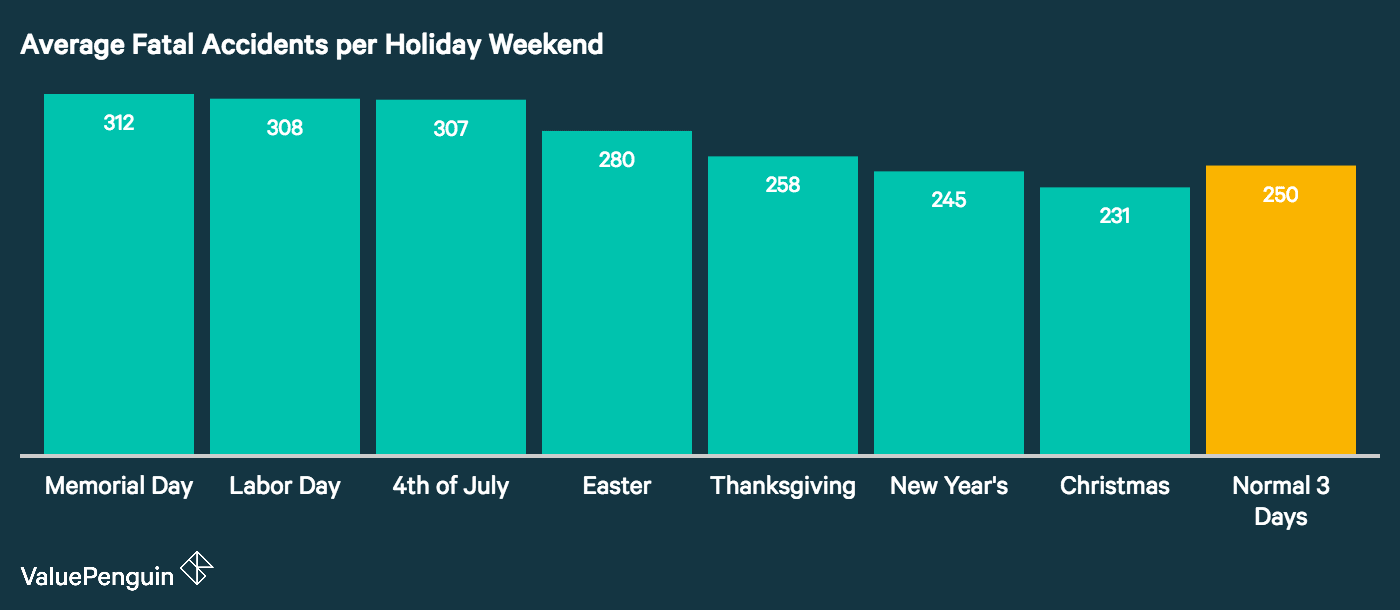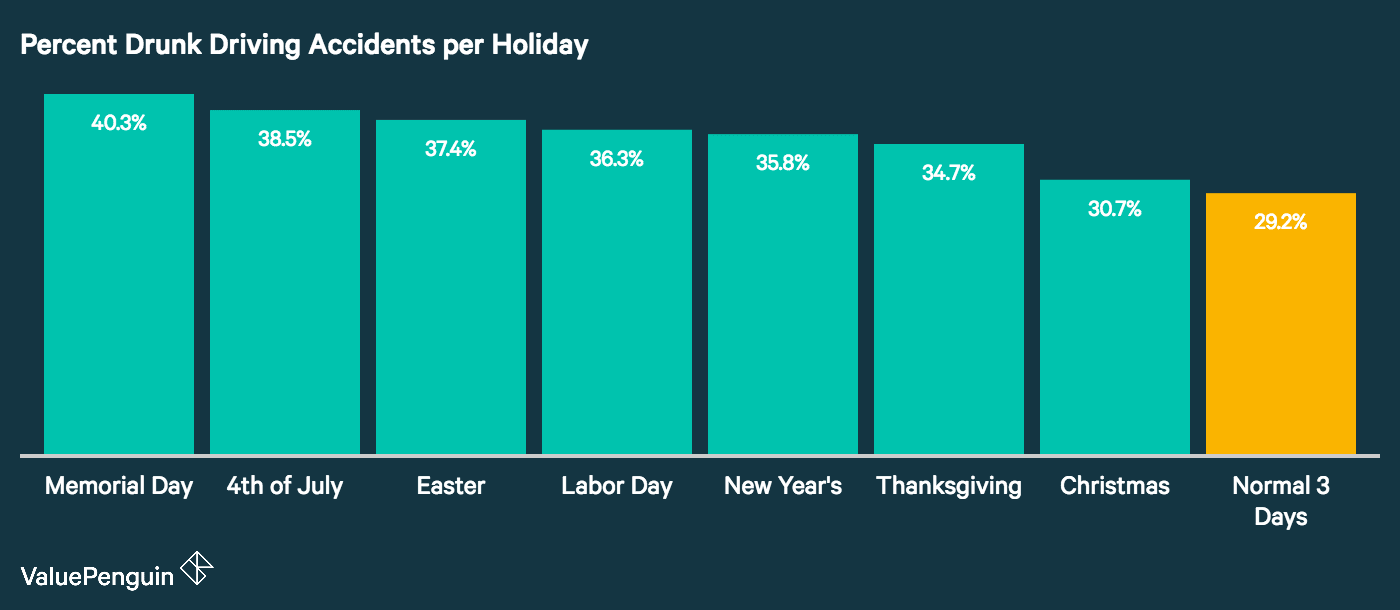Mortality Monday: All About Traffic Deaths!
by meep
And right in time for the most deadly weekend for traffic accidents:
THE DEADLIEST HOLIDAY FOR CAR ACCIDENTS
Drivers and passengers, beware: You are four times as likely to die in a traffic accident over the Memorial Day weekend as over a regular weekend, according to ValuePenguin.
In assessing driving risks, the personal finance website compared traffic fatalities over all the major holidays using statistics from the National Highway Traffic Safety Administration. Memorial Day led with an average of 312 fatal accidents per year over the period 2011 to 2015. The other big summer holidays were not far behind, however. Labor Day averaged 308 fatalities and the Fourth of July, 307.Drivers and passengers, beware: You are four times as likely to die in a traffic accident over the Memorial Day weekend as over a regular weekend, according to ValuePenguin.
In assessing driving risks, the personal finance website compared traffic fatalities over all the major holidays using statistics from the National Highway Traffic Safety Administration. Memorial Day led with an average of 312 fatal accidents per year over the period 2011 to 2015. The other big summer holidays were not far behind, however. Labor Day averaged 308 fatalities and the Fourth of July, 307.
The clear takeaway: Driving on any of the big summer weekend holidays is much more dangerous than on a normal weekend. The most dangerous single day — rather than weekend — is July 4, perhaps because many families are driving at night to and from fireworks displays.
…..
Other highlights of Value Penguin’s study:Surprisingly, New Year’s weekend was the second-least dangerous holiday, with an average of 245 fatal accidents per year between 2011 and 2015. It may be that years of public service announcements have convinced party-goers not to drink and drive. Christmas had the lowest level of fatalities at 231.
As on normal weekends, the stretch of the Northeast between Washington, D.C., and New York had a high incidence of fatal accidents on most holiday weekends.
Texas and California shared in the carnage. The dubious distinction of being the deadliest city on individual holiday weekends was split between Houston and Los Angeles.
Here is the original item from ValuePenguin, in November 2016.
Let’s grab some charts:

I believe that relates to where most people are driving, period.
Take a look at population density:

People are more bunched up here in the northeast. And yes, our traffic is awful. Thanks for asking.
But there really is a holiday effect (or at least a summer weather effect):

You may not be surprised, but there probably is a booze effect, too:

DRUNK DRIVING DEATHS
That said, drunk driving deaths are down quite a bit.
Here is a fact sheet (alas, no graphs):
In the mid 1970s, alcohol was a factor in over 60% of traffic fatalities. Traffic crashes were the leading cause of alcohol-related deaths and two-thirds of traffic deaths among persons aged 16 to 20 involved alcohol.
…..
Since the early 1980s, alcohol-related traffic deaths per population have been cut in half with the greatest proportional declines among persons 16-20 years old.…..
Today alcohol is involved in 37% of all traffic deaths among persons aged 16 to 20.
…..
The number of alcohol-related traffic deaths among 16 to 20 year-olds in the U.S. decreased from 5,244 in 1982 to 1,987 in 2008 in large measure because of the legal drinking age of 21 and Zero Tolerance Laws.
This is the point Kevin Williamson at the National Review makes:
Sobering Success
…..
In fact, police departments put goals of increasing their DUI arrests by a certain percent year-over-year in their budgets: As crimes go, DUI is a moneymaker. DUI may be the least-ignored crime in America.
…..
But here’s the thing: The fight against drunk driving is a success story. A big one. Since the beginning of serious DUI-reform efforts in the early 1980s, we have seen the number of drunk-driving deaths and drunk-driving injuries substantially reduced — by half, across the board, and by more than that when it comes to young people. In the 1970s, alcohol was a factor in 60 percent of traffic deaths and nearly 70 percent of traffic deaths involving young people. Today, that share is closer to a third in both groups. And that’s a smaller share of a smaller total group of fatalities: In 1982, 5,244 people age 16 to 20 died in drunk-driving accidents; by 2008, that number had fallen to 1,987.
…..
Legal and social reform did not solve the problem of drunk driving, and solving the problem presents an unrealistically high bar. We still have drunk driving, we still have too much of it, and people still die from it. But the National Institutes for Health calculates that policy changes prevented something on the order of 150,000 deaths from 1982 to 2001 and continue to prevent about 1,000 traffic deaths a year. That’s something.Read more at: http://www.nationalreview.com/article/447764/drunk-driving-reduction-success-story
Mind you, this is a drop in absolute numbers… and as the population increases, this also means a larger drop in mortality rates.
NATIONAL TRAFFIC FATALITY STATS
Here’s the website for all your traffic fatality data needs.
Some of the research backing up the decrease in drunk driving fatalities. Sure, that goes only up to 2005, but we shall see what’s happened since then.
Oh wait, traffic fatalities are going up again…but not because of drunk driving.
WHY ARE TRAFFIC FATALITIES INCREASING?
And they are.
A new state report blames a 20 percent increase in Washington state traffic fatalities largely on distracted driving and an increasing number of drivers on the road.
In 2015, 1 in 3 crashes involved a driver distracted by a cellphone, eating, adjusting the radio or similar actions that deflected attention from the road, according to a newly released report from the state Traffic Safety Commission.
Of the state’s 499 fatal crashes, 160 were blamed on distracted driving.
Cellphones are among the most common forms of driver distraction. But traffic commission research director Staci Hoff said investigators can’t always determine if a cellphone was being used when an accident occurred. For that reason officials think the actual numbers of crashes involving cellphones is much higher than what are being currently reported.
While some collision data from 2016 has been collected, it has taken the traffic commission until now to compile and analyze the 2015 data to create a comprehensive report on why crashes occur.
….The crashes came at a time when more people are the road, according to the commission, which cited a growing economy for the rise. Others have cited lower gasoline prices. Motorists in Washington drove an estimated 59.7 billion miles in 2015, up from
56.6 billion just three years earlier, according to the report.
Marijuana, which was legalized in Washington in 2014, was a factor in 82 fatal crashes. But Hoff notes other drugs as well as alcohol are also present in many of those crashes.
While fatal crashes involving marijuana rose from 38 the year before it was legalized, the rise is less than many feared, Hoff said.
Still, there’s a need to educate people about the dangers of driving stoned, she said.
…..
And while the number of fatal crashes involving alcohol has slowly fallen over the years, she said the danger from drunk drivers is still much greater than that of stoned drivers.Efforts to curb distracted and intoxicated driving will continue, but there are signs the number of fatal crashes seems to have leveled off for now.
Initial data for 2016 shows the number of fatalities statewide dropped to 535, compared to 551 the year before.
While driving under the influence remains a threat, the biggest danger continues to be distracted driving.
In 2016 alone, Washington State Patrol issued nearly 17,000 citations for driving while using cellphones, said patrol spokesman Sgt. James Prouty in Olympia.
I swear, the one thing that drives me nuts is seeing people TEXTING while on I-84.
WHY ARE PEOPLE SUCH DUMBASSES?
Why drivers use their phones: A cognitive expert weighs in
Eyes off the road, head down texting, vehicle swerving — no one wants to be that driver.
Research has shown that taking eyes off the road for a few seconds or multitasking are as dangerous as driving drunk. Officials say it causes thousands of fatal motor-vehicle crashes annually. Lawmakers over years have responded to the issue with sweeping policy changes across the country, including Washington, where lawmakers are considering proposals to toughen the state’s distracted-driving laws.
So, why do drivers still impulsively reach for their phones?
According to Dr. David Strayer, a cognitive psychologist at the University of Utah whose research on distracted driving has informed people globally, the answer is simple: dopaminergic neurotransmitters. (Or, for nonscientists, chemicals in the brain that signal other parts of the brain to act.)
“When the phone goes off, people feel compelled to look at that phone. They feel compelled because it’s actually a part of their social network that’s reaching out to them,” he said. “It’s triggering some of the dopaminergic neurotransmitter systems that are associated with reward.”
…..
So, while behind the wheel, people with more addictive behavior patterns have a stronger urge to pick up devices for notifications or calls, Strayer said.“They can’t put down the phone, or they can’t not and in the context of trying to drive — it’s just a really dangerous combination.”
Physiology 101: The front part of the brain is called the prefrontal cortex. It’s responsible for multitasking, decision making and planning.
So, when drivers interact with phones or other electronics, while they’re also making decisions on the road, they’re exercising the same part of the brain.
“Our brain is overloaded, that’s really what happens,” Strayer said. “You’re trying to do two separate things at the same time, and there are issues.”
…..
The odds of crashing increases sharply after drivers take their eyes off the road for four seconds, the time it takes to read an average text message, Strayer said. Changing the radio or climate control with a button takes between one and two seconds.Programming a GPS while driving can take up to four to six minutes, Strayer said.
And the distractions don’t have to be physical.
Cognitive distractions are a significant source of crashes, he said. Using voice commands to change music or compose a voice text, for instance, can take more than 15 seconds, according to Strayer.
Most voice-based interactions in new vehicles exceed safe levels of interaction time, he said.“It might seem like a good alternative to keep eyes on the road, but you’re engaging the same parts of the brain,” he said. “Short interactions are safer than long interactions.”
Don’t be that person.
I once got pulled at some checkpoint thingie where they claimed they saw me on my phone (what they probably saw was me reaching up and scratching my head). Thing is, I throw the phone in the back of my car. And it’s almost always off. And it’s a dumbass phone, not a smartphone.
Hell, on my iPads (wifi only), I’ve turned off all notifications except for texts.
DUMB WAYS TO DIE
But seriously, the stories of people who die because they answered a text?
Or, even better, taking selfies while driving?
I mean, if you’re really looking for a dumb way to die, check this out:
Or heck, what about this classic:
There are traffic fatalities that are difficult to avoid. It’s pretty damn easy to NOT TEXT WHILE YOU’RE OPERATING A MOVING VEHICLE.
Related Posts
Merry Christmas! Have Some Finalized 2021 U.S. Mortality Stats!
Mortality with Meep: No, Retiring Later Doesn't Make You Die Sooner... or Later
Mortality with Meep: Cohort vs. Period Mortality Tables
